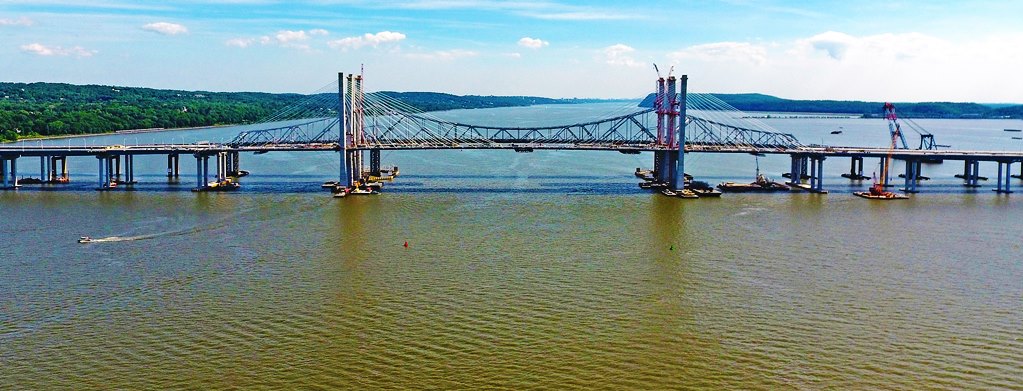On August 22, 2018 it was announced that over 400 oyster reef structures have been placed in the Hudson River near the Governor Mario M. Cuomo Bridge as part of the state’s commitment to re-establish wild oyster population in the river. The new oyster reef system covers more than five acres in the Hudson River.
“Restoring the oyster population is critical to the long-term health of the Hudson River, one of New York’s greatest natural treasures,” New York Governor Andrew M. Cuomo said. “These reefs will help create a strong and healthy marine habitat and protect New York’s environment for generations to come.”
In July, staff from the Billion Oyster Project, a NY Harbor Foundation program, monitored the placement of 422 steel gabion cages, each weighing 250 pounds, and 200- and 300-pound concrete reef balls on the river bed to promote the settlement of larval oysters and the growth of oyster reef habitat. The structures were placed 12 to 20 feet below the surface of the river in three locations near the bridge..
The gabion cages were designed and assembled on Governors Island, where more than 200 BOP volunteers from the tri-state area filled them with empty oyster shells donated by more than 70 New York City restaurants. The oyster reef structures are the largest reef system in Billion Oyster Project history. The Thruway Authority will monitor the cages and reef balls through 2020 to measure oyster population growth, survival and water quality.
Construction of the Governor Mario M. Cuomo Bridge required the relocation of some living oyster habitats. As part of the project’s environmental stewardship commitments, the New York State Thruway Authority established an oyster working group and funded research to help lead the restoration effort.
DEC Commissioner Basil Seggos added, “Completion of the Oyster Restoration Project is a reflection of Governor Andrew Cuomo’s fierce commitment to protect our natural resources and is a fitting tribute to his family’s proud tradition of environmental excellence. The Hudson River Estuary once boasted healthy oyster beds, providing valuable ecosystem services to the region by filtering water, providing habitat for other marine species and a boon to local economies. Today’s announcement will work to reestablish this area as healthy oyster habitat.”
In 2015, the Thruway Authority partnered with scientists and oyster restoration experts including the Billion Oyster Project, the Hudson River Foundation and the University of New Hampshire on a two-year pilot study to design and construct reef habitat structures and determine appropriate locations for placement on the bed of the Hudson River. The oyster working group included Hudson Riverkeeper, Scenic Hudson, NY/NJ Baykeeper, Cornell University, the National Oceanic and Atmospheric Administration (NOAA), the Federal Highway Administration (FHA) and the New York State Department of Environmental Conservation.
“Under the leadership of Governor Cuomo, the project team building the new bridge has been fully committed to protecting the Hudson River and its rich marine life,” Thruway Authority Acting Executive Director Matthew J. Driscoll said. “Adding these underwater structures to encourage oyster habitat supports our goal to preserve our valuable natural resources.
The 3.1-mile Governor Mario M. Cuomo Bridge is the first cable-stayed bridge across the Hudson River and replaced the 62-year Tappan Zee Bridge. Featuring eight 419-foot towers standing at a five-degree angle, the new bridge has a total of 192 stay cables. Last year, all traffic was shifted onto the new bridge’s westbound span in a temporary traffic configuration (four traffic lanes in each direction). Since then, design-builder Tappan Zee Constructors has been dismantling the old bridge while also constructing the eastbound span, which is scheduled to open to traffic later this year.
Once the project is complete, the public will reap the full benefits of the new twin-span, including:
- Eight general traffic lanes;
- Four breakdown and emergency lanes;
- Dedicated bus lanes and space for commuter rail; and
- A bicycle and walking path.
Pete Malinowski, Co-founder and Executive Director, BOP, said, “All of us at Billion Oyster Project are grateful to Governor Cuomo for the opportunity to construct over 400 reef structures for the largest reef installation in Billion Oyster Project history. We see this restoration project as setting a powerful example of how people can come together in service of a vision to make New York Harbor, and New York City, more sustainable. Hundreds of volunteers from the tri-state area helped us build and assemble the reef structures, Harbor School students and staff took on leadership roles in the design and building of the structures, and over 70 New York City restaurants donated the shells that make it possible for oysters to survive and thrive in the Hudson River.“

